Effect of Flexible Tank Wall on Seismic Response of Horizontal Storage Tank
Abstract
:1. Introduction
2. Analysis Method
2.1. Fundamental Assumptions
2.2. Impulsive Velocity Potential
2.3. Convective Sloshing Velocity Potential
2.4. Simplified Mechanical Model
2.4.1. Liquid Dynamic Pressure
2.4.2. Tank Wall Inertia Force
3. Validation
4. Simplified Mechanical Model Parameter Analysis
5. Case Analysis
- a.
- El-Centro (EW), Imperial Valley, California, 18 May 1940; duration: 53.46 s;
- b.
- Taft (NS), Kern County, California, 21 July 1952; duration: 54.36 s;
- c.
- CPC-TOPANGA CANYON BLVD., Canoga Park, California, 17 January 1994; duration: 55.58 s.
6. Conclusions
- (1)
- The influence of a flexible tank wall’s effect on the seismic response of a horizontal tank is closely related to the radius, aspect ratio, diameter–thickness ratio, and H/R of the tank. The larger these parameters are, the more obvious the effect is.
- (2)
- Considering the flexible tank wall, the liquid dynamic pressure peak appears in the middle of the storage tank and at the connection between the cylinder and the head.
- (3)
- Compared with a rigid tank wall, a flexible tank wall has an amplification effect on the seismic response of the liquid dynamic pressure peak, base shear, and overturning bending moment.
Author Contributions
Funding
Data Availability Statement
Conflicts of Interest
References
- Fiore, A.; Rago, C.; Vanzi, I.; Greco, R.; Briseghella, B. Seismic behavior of a low-rise horizontal cylindrical tank. Int. J. Adv. Struct. Eng. 2018, 10, 143–152. [Google Scholar] [CrossRef]
- Ormeño, M.; Larkin, T.; Chouw, N. Experimental study of the effect of a flexible base on the seismic response of a liquid storage tank. Thin-Walled Struct. 2019, 139, 334–346. [Google Scholar] [CrossRef]
- Haroun, M.A.; Housner, G.W. Seismic design of liquid storage tanks. J. Tech. Counc. ASCE 1981, 107, 191–207. [Google Scholar] [CrossRef]
- Zhao, Y.; Li, H.-N.; Zhang, S.; Mercan, O.; Zhang, C. Seismic analysis of a large LNG tank considering different site conditions. Appl. Sci. 2020, 10, 8121. [Google Scholar] [CrossRef]
- Peek, R. Analysis of unanchored liquid storage tanks under lateral loads. Earthq. Eng. Struct. Dyn. 1988, 16, 1087–1100. [Google Scholar] [CrossRef]
- Karamanos, S.A.; Kouka, A. A refined analytical model for earthquake-induced sloshing in half–full deformable horizontal cylindrical liquid containers. Soil Dyn. Earthq. Eng. 2016, 85, 191–201. [Google Scholar] [CrossRef]
- Lyu, Y.; Sun, J.-G.; Sun, Z.-G.; Cui, L.F.; Wang, Z. Simplified mechanical model for seismic design of horizontal storage tank considering soil-tank-liquid interaction. Ocean Eng. 2020, 198, 106953. [Google Scholar] [CrossRef]
- Hamdan, F. Seismic behaviour of cylindrical steel liquid storage tanks. J. Constr. Steel Res. 2000, 53, 307–333. [Google Scholar] [CrossRef]
- Wu, J.-Y.; Yu, Q.-Q.; Peng, Q.; Gu, X.-L. Seismic responses of liquid storage tanks subjected to vertical excitation of near-fault earthquakes. Eng. Struct. 2023, 289, 116284. [Google Scholar] [CrossRef]
- Güler, E.; Alhan, C. Performance Limits of Base-Isolated Liquid Storage Tanks with/without Supplemental Dampers under Near-Fault Earthquakes. In Structures; Elsevier: Amsterdam, The Netherlands, 2021; pp. 355–367. [Google Scholar]
- Gabbianelli, G.; Milanesi, R.R.; Gandelli, E.; Dubini, P.; Nascimbene, R. Seismic vulnerability assessment of steel storage tanks protected through sliding isolators. Earthq. Eng. Struct. Dyn. 2023, 52, 2597–2618. [Google Scholar] [CrossRef]
- Merino, R.; Brunesi, E.; Nascimbene, R. Probabilistic evaluation of earthquake-induced sloshing wave height in above-ground liquid storage tanks. Eng. Struct. 2020, 202, 109870. [Google Scholar] [CrossRef]
- Ghoohestani, S.; Shekari, M.R.; Zareifard, M.R.; Amiri, S.M. On the nonlinear seismic response of liquid filled thin-walled steel elevated containers isolated by bearings to earthquake ground motions. Int. J. Press. Vessel. Pip. 2022, 199, 104754. [Google Scholar] [CrossRef]
- Park, J.; Askarinejad, H.; Pourbehi, M.S. Seismic evaluation of flexible steel water storage tanks. Proc. Int. Struct. Eng. Constr. 2022, 9, STR28. [Google Scholar]
- Bohra, H.; Azzuni, E.; Guzey, S. Seismic analysis of open-top storage tanks with flexible foundation. J. Press. Vessel Technol. 2019, 141, 041801. [Google Scholar] [CrossRef]
- Ji, J.; Song, H.; Xu, M.; Li, Z.; Wang, X.; Jiang, L. Finite Element Analysis and Test Verification of Super-Large Vertical Steel Storage Tank; IOP Publishing: Bristol, UK, 2020; p. 012151. [Google Scholar]
- Shekari, M.R.; Hekmatzadeh, A.A.; Amiri, S.M. On the nonlinear dynamic analysis of base-isolated three-dimensional rectangular thin-walled steel tanks equipped with vertical baffle. Thin-Walled Struct. 2019, 138, 79–94. [Google Scholar] [CrossRef]
- Al-Yacouby, A.M.; Hao, L.J.; Liew, M.; Ratnayake, R.C.; Samarakoon, S.M. Thin-walled cylindrical shell storage tank under blast impacts: Finite element analysis. Materials 2021, 14, 7100. [Google Scholar] [CrossRef] [PubMed]
- Rawat, A.; Matsagar, V.A.; Nagpal, A. Numerical study of base-isolated cylindrical liquid storage tanks using coupled acoustic-structural approach. Soil Dyn. Earthq. Eng. 2019, 119, 196–219. [Google Scholar] [CrossRef]
- Saria, A.; Djermane, M.; Hadj-Djelloul, N.D. Three-dimensional nonlinear dynamic analysis of base isolated cylindrical steel tank. Civ. Eng. J. 2022, 8, 753–762. [Google Scholar] [CrossRef]
- Lee, J.H.; Cho, J.-R.; Han, S.-W. Time-domain earthquake response analysis of rectangular liquid storage tank considering fluid-structure-soil interaction. J. Comput. Struct. Eng. Inst. Korea 2020, 33, 383–390. [Google Scholar] [CrossRef]
- Hashemi, S.; Ehteshami, A.; Rahmani, B. Dynamic behavior of elevated and ground-supported, base-isolated, flexible, concrete cylindrical fluid containers. J. Struct. Constr. Eng. 2021, 8, 345–366. [Google Scholar]
- Tsipianitis, A.; Tsompanakis, Y. Optimizing the seismic response of base-isolated liquid storage tanks using swarm intelligence algorithms. Comput. Struct. 2021, 243, 106407. [Google Scholar] [CrossRef]
- Lee, J.-H.; Cho, J.-R. Simplified earthquake response analysis of rectangular liquid storage tanks considering fluid-structure interactions. Eng. Struct. 2024, 300, 117157. [Google Scholar] [CrossRef]
- Spritzer, J.; Bohra, H.; Guzey, S. Imperfection-sensitivity of unanchored aboveground open-top steel welded liquid storage tanks subjected to seismic loads. SN Appl. Sci. 2019, 1, 1–21. [Google Scholar] [CrossRef]
- Huang, J.; Chen, Z.; Jiao, P. Seismic Dynamic Response Analysis of Liquid Storage Tank Under Uneven Foundation Settlement Based on Fluid-Structure Interaction. In Pressure Vessels and Piping Conference; American Society of Mechanical Engineers: New York City, NY, USA, 2023. [Google Scholar]
- Verma, S. Seismic Analysis of Circular Elevated Water Tank Designed by Indian Standard and European Standard Code. Int. J. Res. Appl. Sci. Eng. Technol. 2021, 9, 1638–1641. [Google Scholar] [CrossRef]
- Mamaghani, I.H.P.; RoopKumdee, W. Seismic Response of LNG Storage Tanks under Earthquake Excitations. In Proceedings of the 6th International Conference on Civil, Structural and Transportation Engineering, Online, 17–19 May 2021. [Google Scholar]
- Phan, H.N.; Paolacci, F.; Di Filippo, R.; Bursi, O.S. Seismic vulnerability of above-ground storage tanks with unanchored support conditions for Na-tech risks based on Gaussian process regression. Bull. Earthq. Eng. 2020, 18, 6883–6906. [Google Scholar] [CrossRef]
- Luo, D.; Liu, C.; Sun, J.; Cui, L.; Wang, Z. Liquefied natural gas storage tank simplified mechanical model and seismic response analysis. Soil Dyn. Earthq. Eng. 2021, 141, 106491. [Google Scholar] [CrossRef]
- Patkas, L.; Karamanos, S. Variational solutions for externally induced sloshing in horizontal-cylindrical and spherical vessels. J. Eng. Mech. 2007, 133, 641–655. [Google Scholar] [CrossRef]
- Lyu, Y.; Sun, J.-G.; Sun, Z.-G.; Cui, L.-F.; Wang, Z. Seismic response calculation method and shaking table test of horizontal storage tanks under lateral excitation. Earthq. Engng. Struct. Dyn. 2021, 50, 619–634. [Google Scholar] [CrossRef]
- HG-T-3154; Standard of Ministry of Chemical Industry of the People’s Republic of China: Horizontal Oval Head Storage Tank Series. Ministry of Chemical Industry of the People’s Republic of China: Beijing, China, 1985.
- McIver, P. Sloshing frequencies for cylindrical and spherical containers filled to an arbitrary depth. J. Fluid Mech. 1989, 201, 243–257. [Google Scholar] [CrossRef]
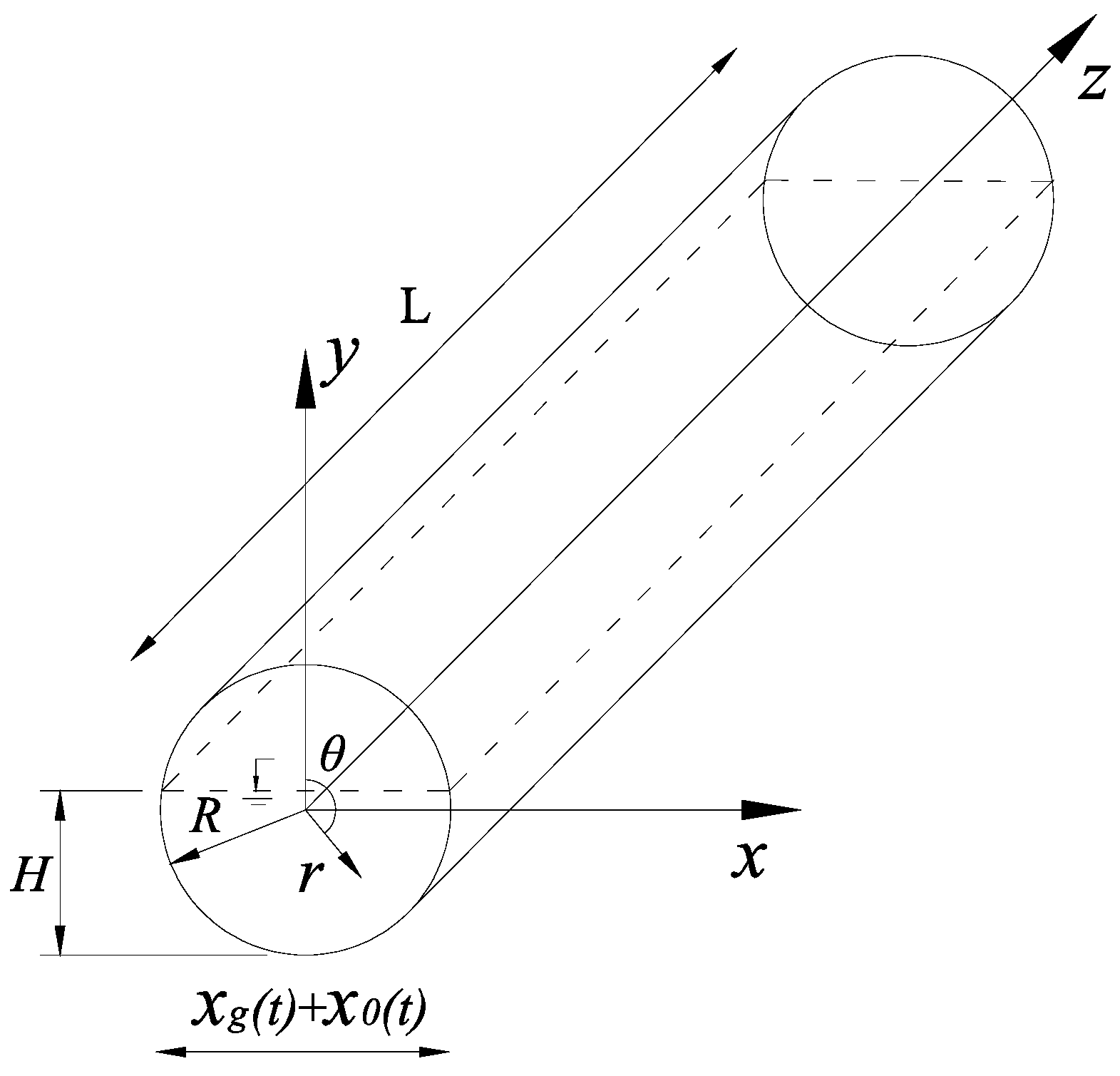
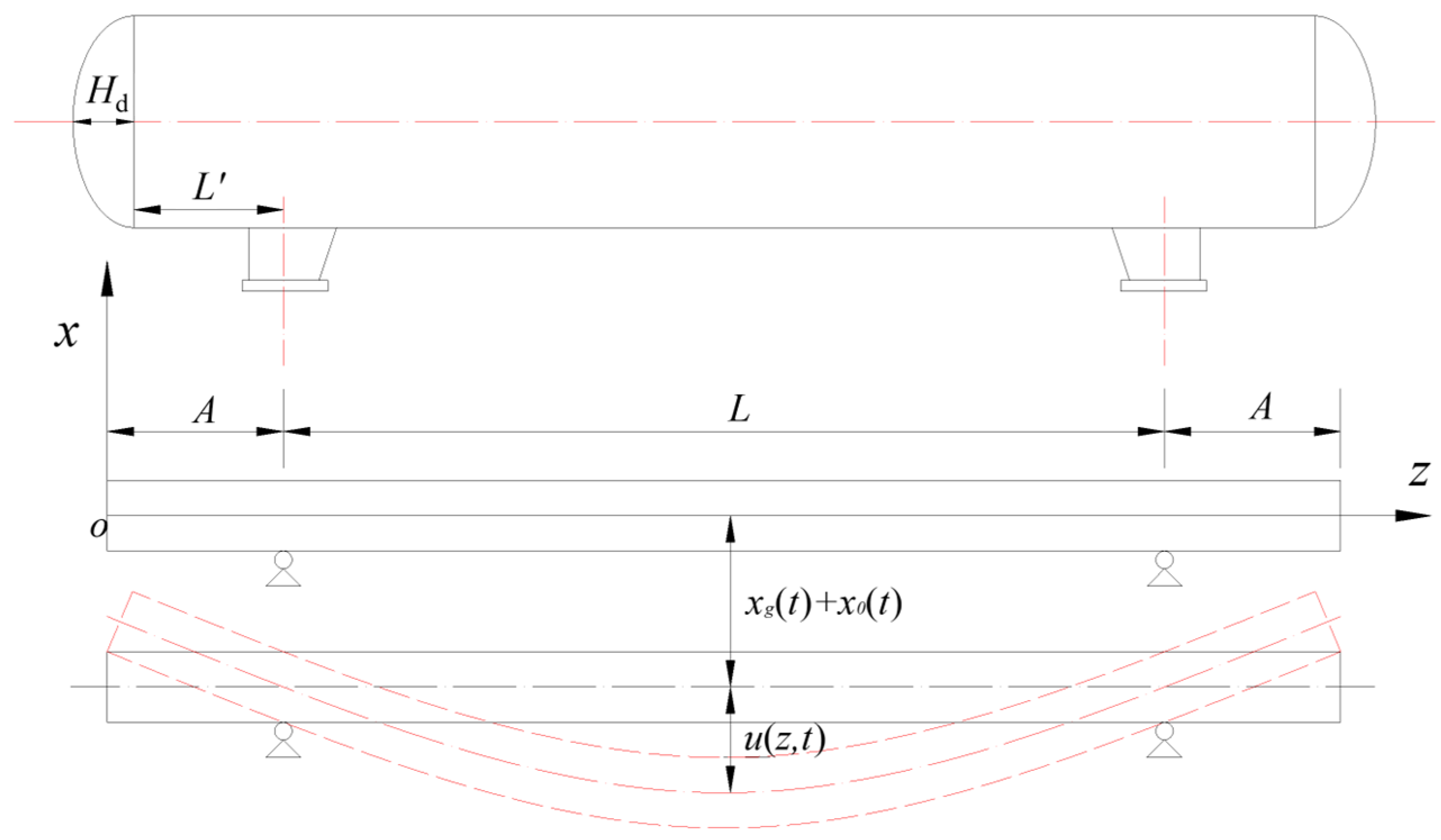
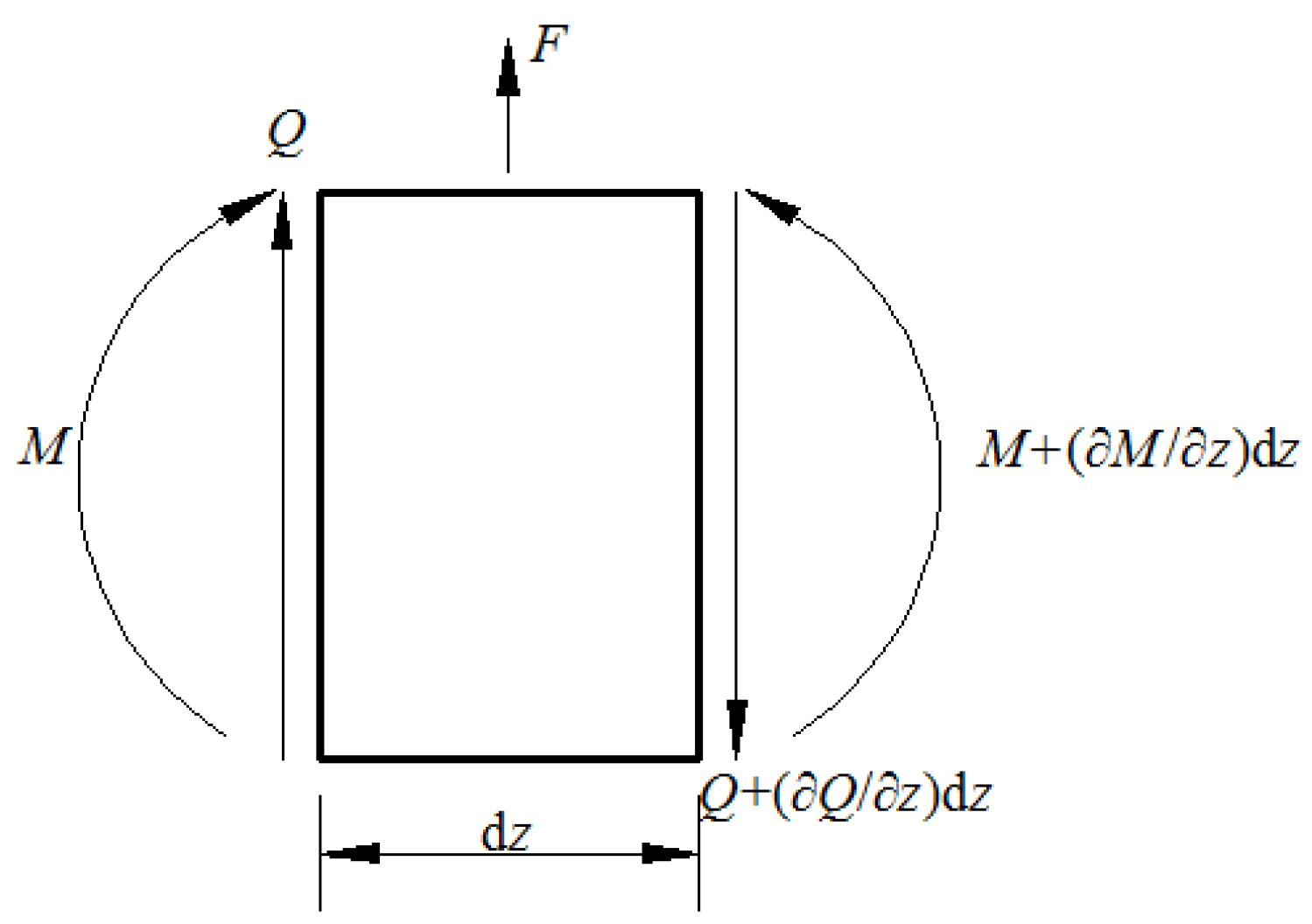
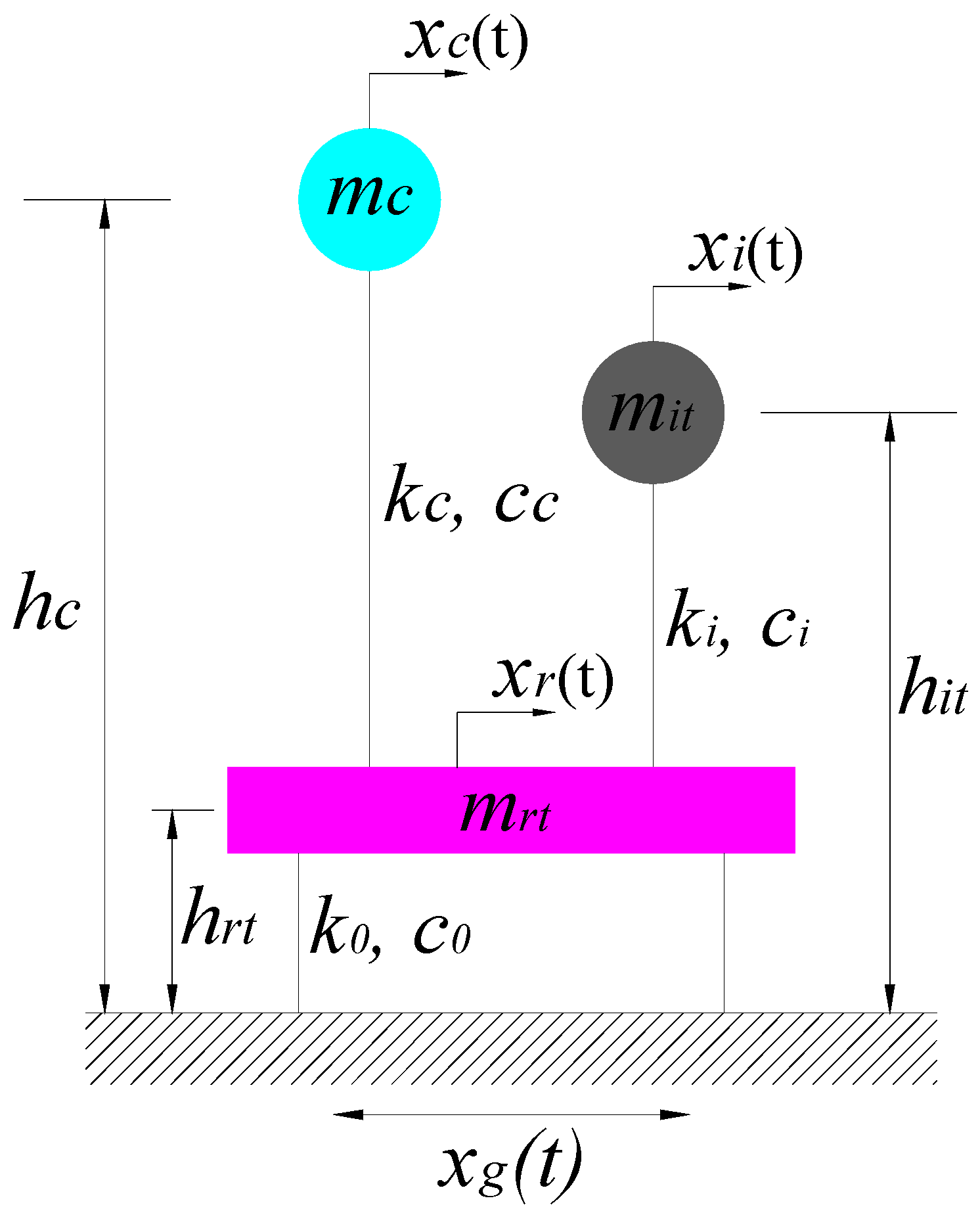
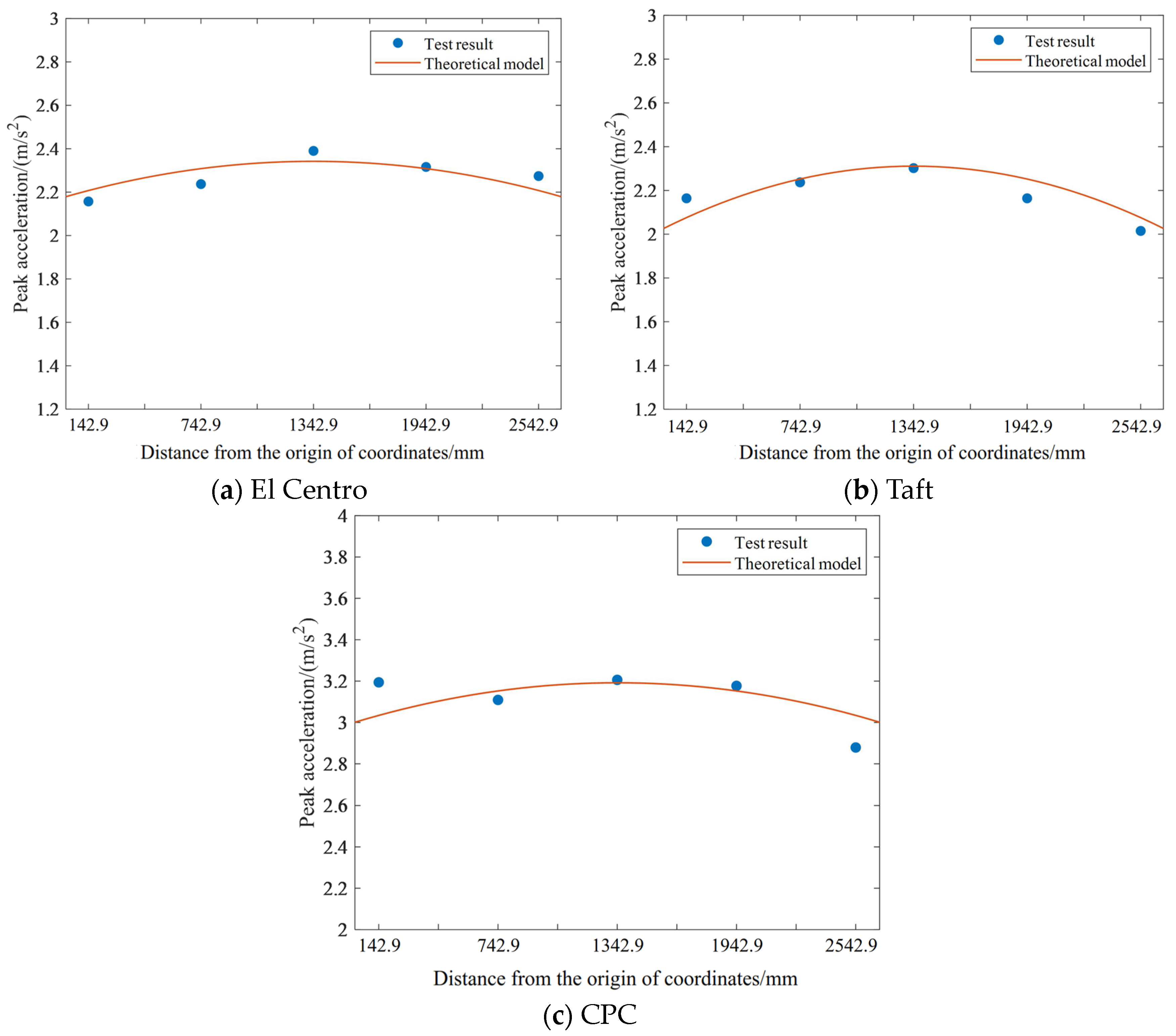
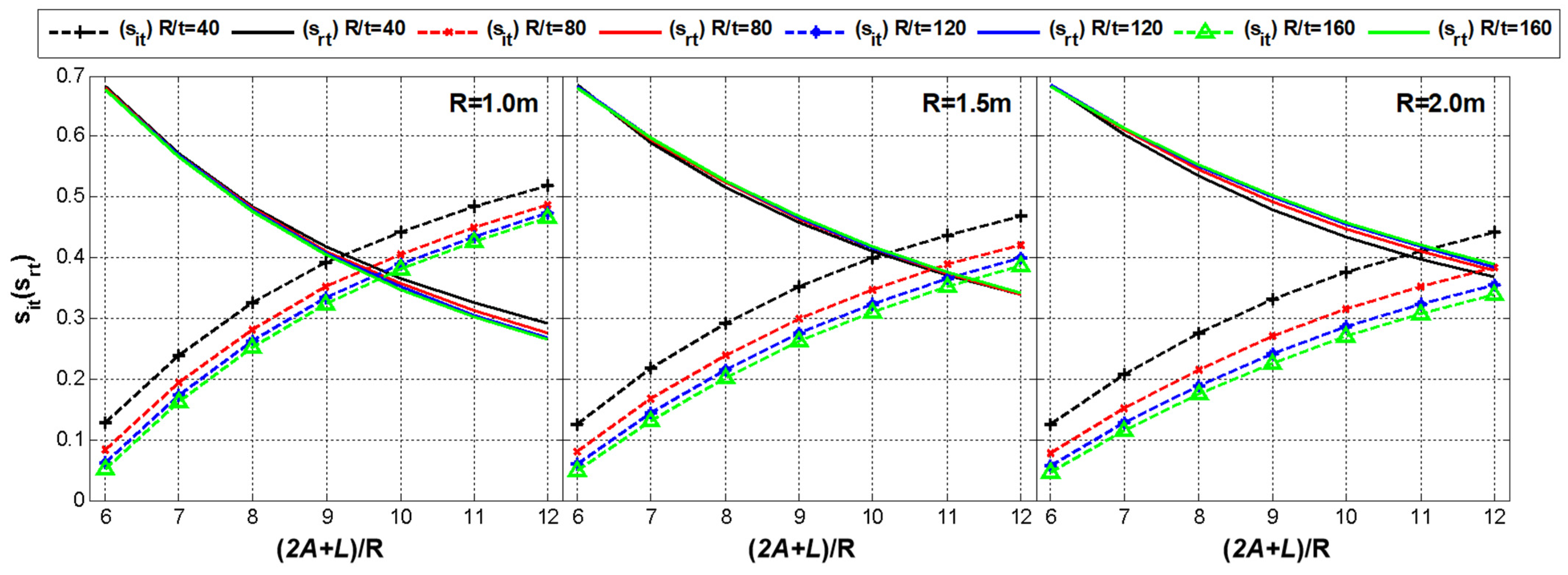





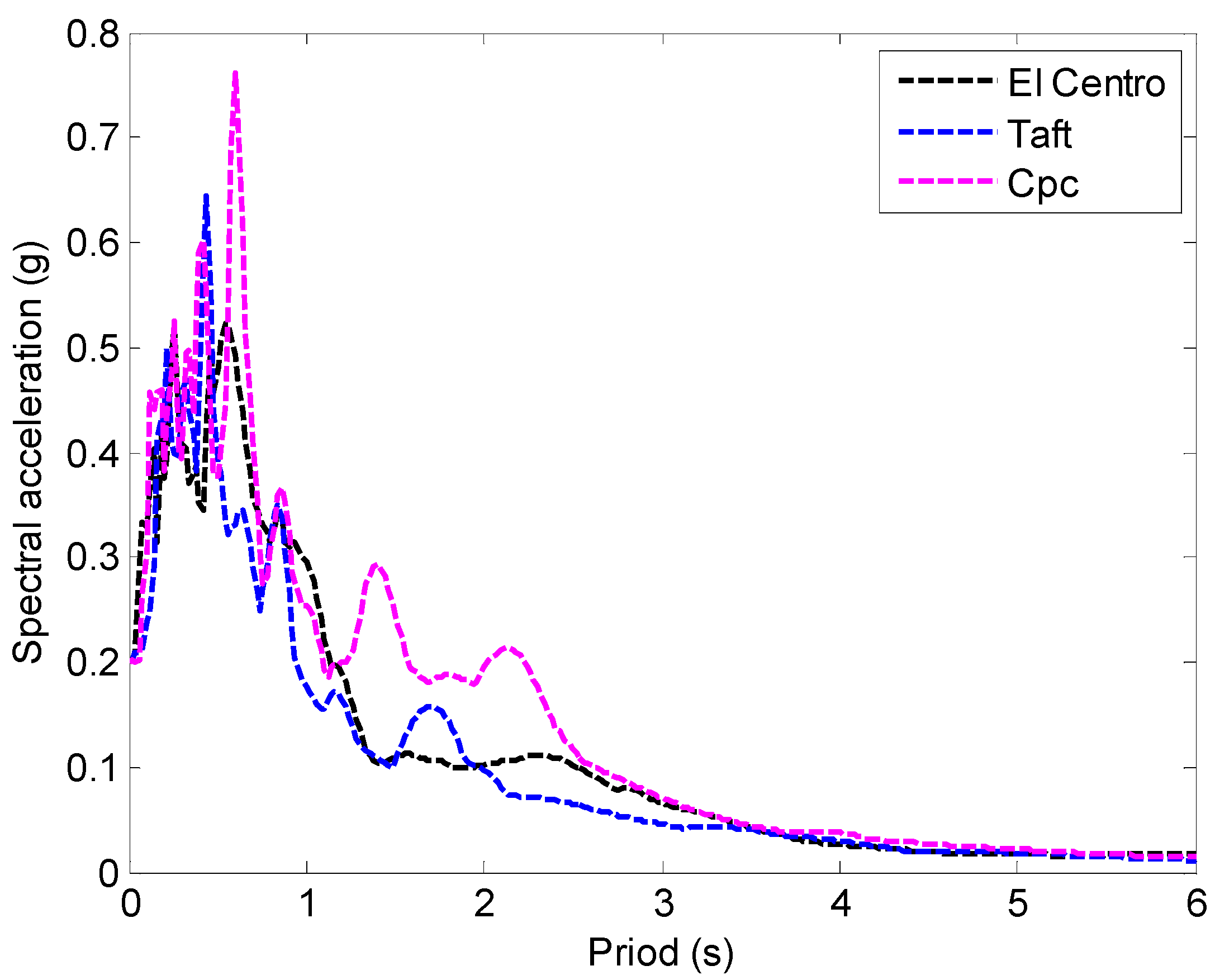
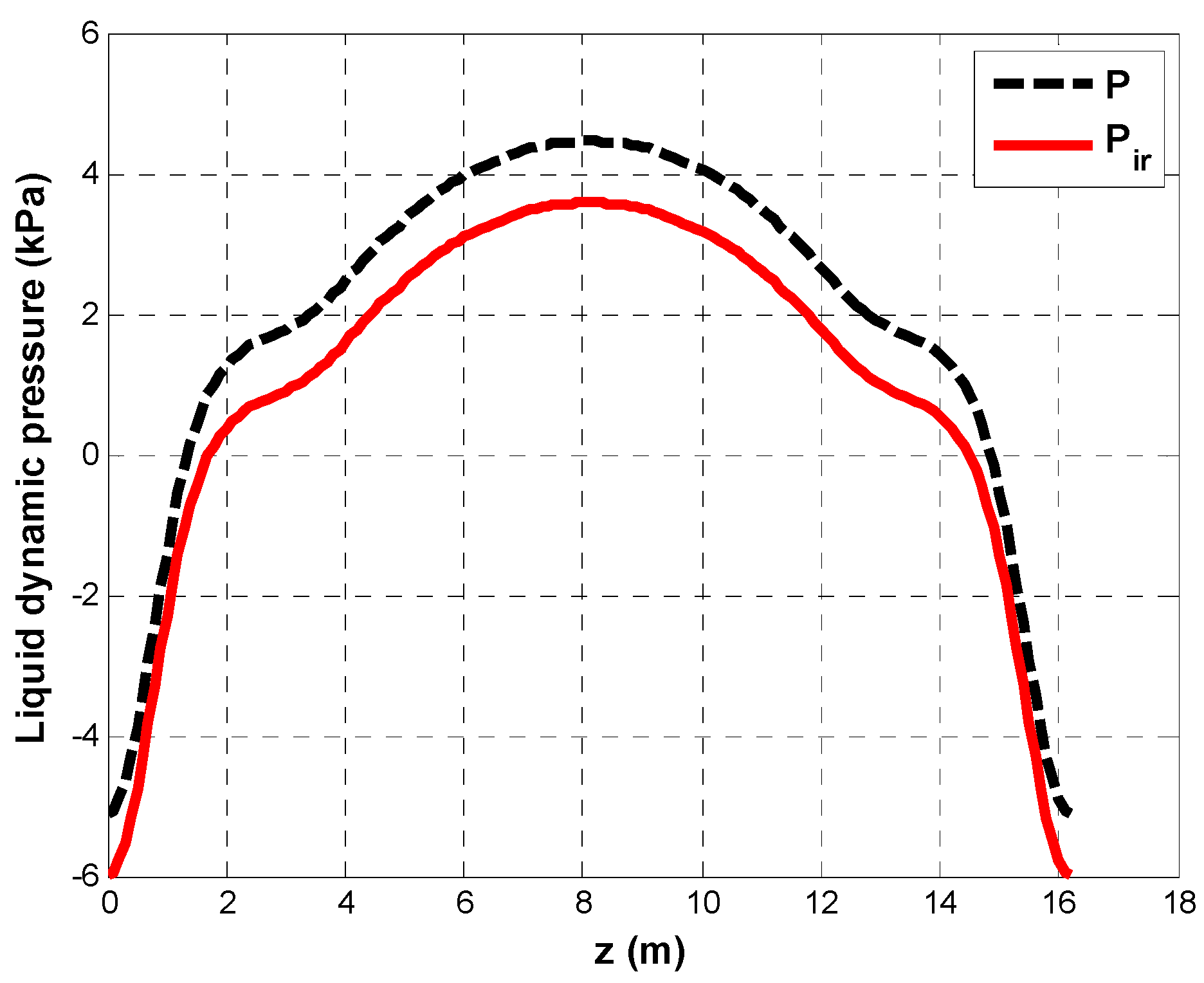
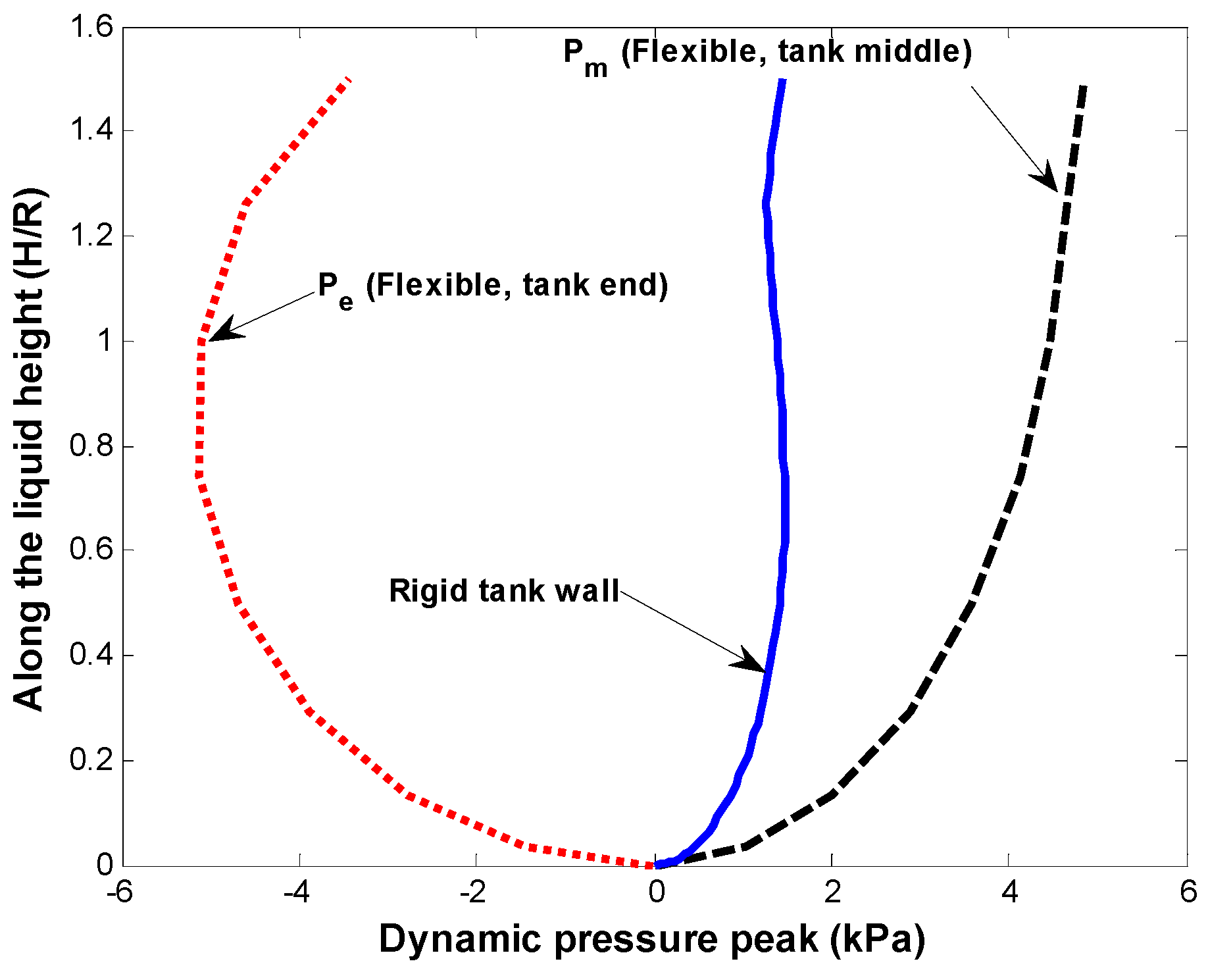
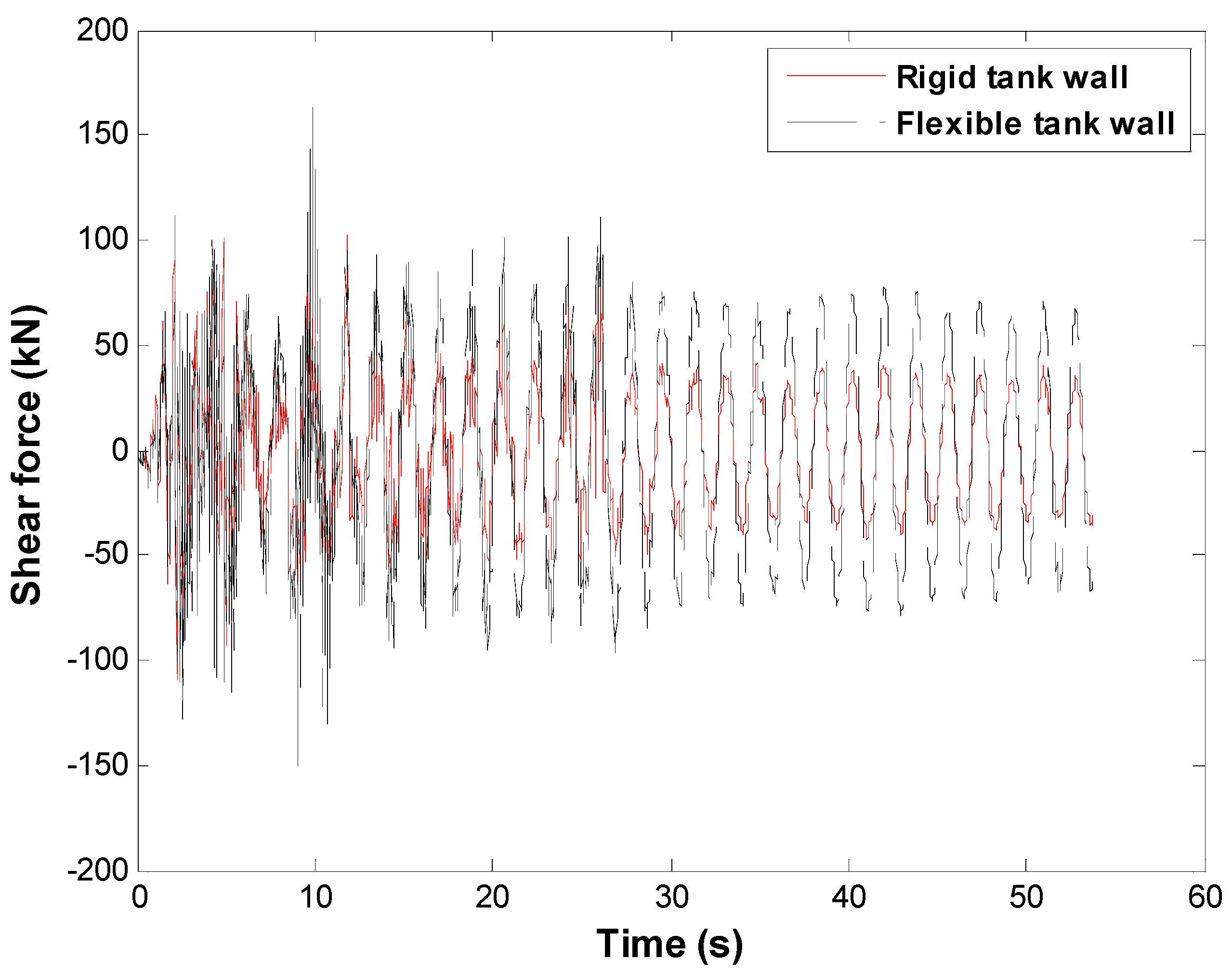

| Seismic Excitation | Comparison Item | Measuring Point | ||||
|---|---|---|---|---|---|---|
| El Centro | Analytical solutions (m/s2) | 2.207 | 2.308 | 2.342 | 2.308 | 2.208 |
| Test results (m/s2) | 2.157 | 2.237 | 2.390 | 2.316 | 2.274 | |
| Error (%) | 2.27 | 3.08 | −2.05 | −0.35 | −2.99 | |
| Taft | Analytical solutions (m/s2) | 2.076 | 2.252 | 2.311 | 2.252 | 2.076 |
| Test results (m/s2) | 2.164 | 2.237 | 2.302 | 2.164 | 2.015 | |
| Error (%) | −4.23 | 0.67 | 0.39 | 3.91 | 2.94 | |
| CPC | Analytical solutions (m/s2) | 3.034 | 3.152 | 3.192 | 3.152 | 3.034 |
| Test results (m/s2) | 3.194 | 3.109 | 3.206 | 3.177 | 2.879 | |
| Error (%) | −5.27 | 1.36 | −0.44 | −0.79 | 5.11 | |
| Parts | Structural Parameters | Size/mm |
|---|---|---|
| Oval head | Head depth | 790 |
| Head wall thickness | 12 | |
| Tank body | Length | 1460 |
| Inside diameter | 3000 | |
| Wall thickness | 12 | |
| Saddle | Distance from the center of the saddle to the tangent of the head | 800 |
| Width | 360 | |
| Height | 250 | |
| Saddle wrap angle | 120º |
| Seismic Response | Analysis Method | El-Centro | Taft | CPC |
|---|---|---|---|---|
| Shear force (kN) | Flexible | 163.0 | 152.1 | 159.6 |
| Rigid | 111.2 | 124.7 | 137.1 | |
| Error (%) | −46.58 | −21.97 | −16.48 | |
| Bending moment (kN·m) | Flexible | 222.4 | 219.7 | 226.1 |
| Rigid | 163.7 | 189.3 | 204.5 | |
| Error (%) | −35.86 | −16.06 | −10.56 |
Disclaimer/Publisher’s Note: The statements, opinions and data contained in all publications are solely those of the individual author(s) and contributor(s) and not of MDPI and/or the editor(s). MDPI and/or the editor(s) disclaim responsibility for any injury to people or property resulting from any ideas, methods, instructions or products referred to in the content. |
© 2024 by the authors. Licensee MDPI, Basel, Switzerland. This article is an open access article distributed under the terms and conditions of the Creative Commons Attribution (CC BY) license (https://creativecommons.org/licenses/by/4.0/).
Share and Cite
Cui, L.; Zhu, L.; Lyu, Y.; Sun, J.; Wu, Y. Effect of Flexible Tank Wall on Seismic Response of Horizontal Storage Tank. Processes 2024, 12, 1633. https://doi.org/10.3390/pr12081633
Cui L, Zhu L, Lyu Y, Sun J, Wu Y. Effect of Flexible Tank Wall on Seismic Response of Horizontal Storage Tank. Processes. 2024; 12(8):1633. https://doi.org/10.3390/pr12081633
Chicago/Turabian StyleCui, Lifu, Lijie Zhu, Yuan Lyu, Jiangang Sun, and Yujian Wu. 2024. "Effect of Flexible Tank Wall on Seismic Response of Horizontal Storage Tank" Processes 12, no. 8: 1633. https://doi.org/10.3390/pr12081633






